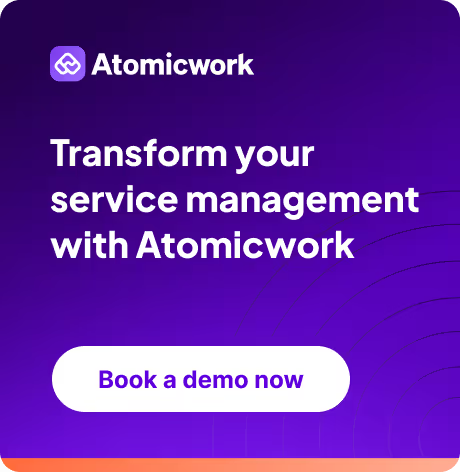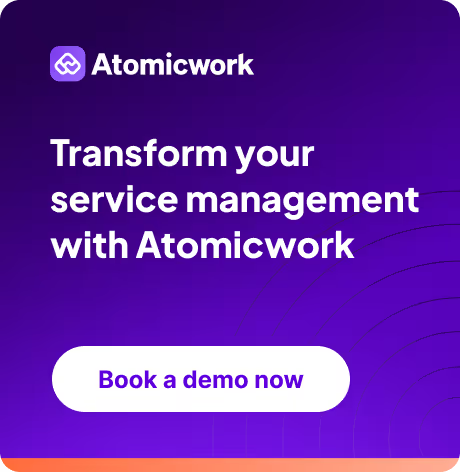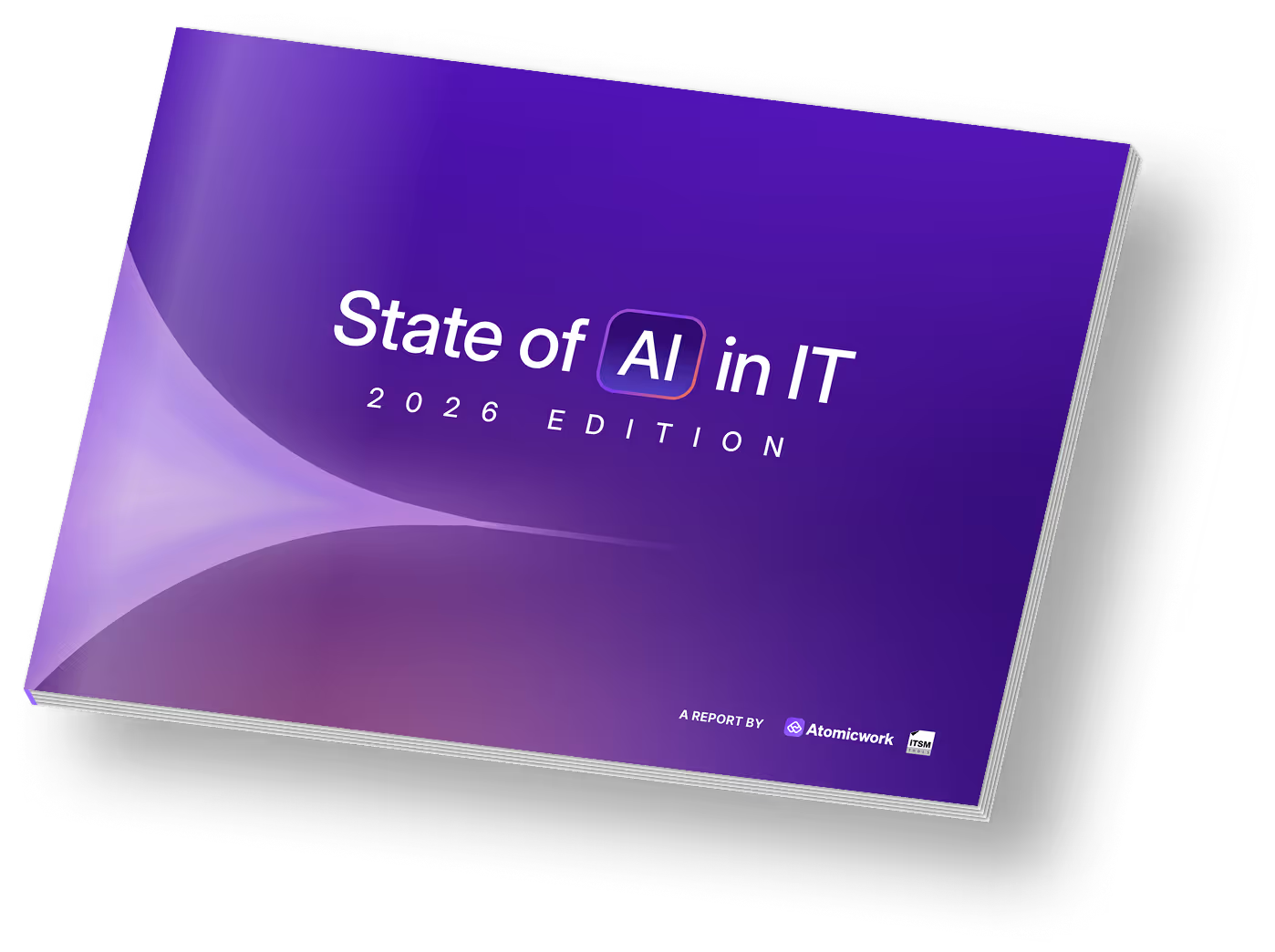How IT leaders can manage SaaS fatigue and employee productivity with modern service management

Today’s enterprise SaaS landscape is complex.
SaaS tools are undoubtedly essential to running operations efficiently, but the rampant proliferation of tools leads to what’s now commonly referred to as the ‘SaaS sprawl’.
With too many applications, organizations need more data, better employee experiences, and overall operational inefficiencies.
Gartner reports that the per-employee SaaS spend averages at $1,370, and most organizations are only aware of 40% of their SaaS applications”
In this article, we examine the problems enterprises face with having too many SaaS tools and how IT leaders can help optimize the organizational tech stack.
Challenges posed by SaaS sprawl
The fragmented tools landscape severely challenges employees, service teams, and businesses.
1. Constant context switching for employees
Asana reported that, on average, employees switch between 13 different tools approximately 30 times daily. This constant toggling between apps to retrieve information fragments their workflow, significantly lowering workplace productivity.
According to McKinsey, employees spend 20% of their time looking for documents or tracking down colleagues. This fragmented ethos results in information being scattered across various platforms, access and security lapses, tracking licence and app use, increased costs, wasting time and frustration.

The SaaS sprawl exacerbates this issue by requiring employees to juggle between multiple tools, none of which are seamlessly integrated, leaving them overwhelmed by unnecessary complexity. Many SaaS management solutions address parts of the problem leaving the employees and IT frustrations perpetuated.
2. Operational inefficiency for support teams
SaaS sprawl is equally burdensome for IT, security, and support teams. It creates operational inefficiencies that lead to time-consuming, repetitive tasks. IT support staff are often burdened with a high volume of simple issues like access to apps, password resets or basic troubleshooting across disconnected systems, resulting in longer wait times and poor user experiences.
For instance, requests as simple as password resets could cost your organization up to ~$85K/year, considering the productivity loss of both your IT team and employees in a thousand-membered enterprise.
There is also a knowledge deficiency across teams, and fragmented knowledge bases are leading to many open requests, gaps in resolution, and process delays, which in turn frustrate employees. Traditional service management tools barely address this issue without causing employee frustration leading to hiring more IT staff.
This prolongs issue resolution and increases agents' cognitive load, making it difficult for them to streamline their training, documentation, operations and maintain performance.
3. Higher cost of ownership for businesses
The proliferation of SaaS tools comes at a steep price for businesses. Maintaining licenses, integrations, and workflows across numerous platforms drives up the total cost of ownership (TCO).
“Many large firms will have been hit by 2023’s unprecedented series of inflation-driven price increases. With SaaS costs rising 25-30% suddenly from many vendors, it’s more important to identify license waste and application sprawl,” says the Gartner Magic Quadrant report quoted above.
This ‘sprawl’ increases the complexity and expense of managing software assets and the time spent manually tracking software licence, use, and support, thus increasing the risk.
In addition to the direct financial cost, interoperability between these tools leads to inefficient workflows, with bolt-on AI assistants, additional workflow automation platforms (iPaaS), and ITSM systems requiring heavy customizations that increase operational costs.
How AI-powered modern service management helps manage SaaS sprawl
Modern service management reimagines employee support by seamlessly integrating service management into the flow of work, making it more accessible and efficient for end-users.
Instead of requiring employees to navigate multiple tools and portals, they can now access enterprise-grade AI assistants—like Atom—on familiar collaboration platforms such as Slack and Microsoft Teams, where they already spend their time. This eliminates constant app-switching, reduces SaaS fatigue, and enhances productivity across the enterprise.
With a modern service management platform, teams from IT, HR, Finance, and Operations can centralize employee records, offering faster, more contextual service delivery. By breaking down departmental silos and providing a single source of truth, this approach not only improves the employee experience but also accelerates issue resolution, driving greater efficiency and collaboration across the organization.

Let’s break down what modern service management could mean for your enterprise.
1. Drastically simplifies end-user interactions
Modern service management simplifies end-user interactions by eliminating the need for clunky, outdated portals and siloed applications.
Instead of employees having to switch between multiple platforms to retrieve information, AI assistants—powered by large language models (LLMs)—can contextually understand queries and pull data from various apps without requiring users to leave their primary workspace.
For instance, a sales team member needing access or status of a lead no longer has to log into Salesforce; they can simply ask an AI assistant, like Atomicwork's Atom, to request access, get necessary approvals in minutes and go on to retrieve the information. This consolidation minimizes app switching, streamlining user interactions and boosting productivity across teams.
2. Multiplied agent productivity gains
Modern service management not only empowers end-users to self-serve and resolve simple requests faster but also deflects repetitive, high-volume queries from IT teams. This significantly boosts support team efficiency, allowing agents to focus on more complex, critical issues.
For example, US-based safety glove distributor Ammex Corp implemented Atomicwork’s AI-powered modern service platform and achieved a 65% end-user deflection rate without increasing agent headcount in 6 months.
Ammex was able to successfully reduce resolution times, improve team efficiency, and enhance user satisfaction across the organization.

Additionally, a modern service management platform enables seamless integration and workflow automation across different apps and systems to handle incidents, requests, assets, or changes, including knowledge management with smart employee context.
With workflows centralized in a single platform, AI can learn from agent interactions and offer intelligent workflow suggestions, accelerating resolution times. Moreover, AI can access key systems of record, such as identifying the requester’s department when processing Salesforce access requests, and automatically grant permissions—eliminating manual intervention.
This continuous learning and adaptability allow agents to spend less time on routine tasks and more on delivering high-quality support, ultimately enhancing overall productivity.
3. Reduced TCO and better ROI
Implementing a unified AI-powered modern service management platform reduces the total cost of ownership by consolidating various functionalities, such as AI assistance, workflow automation, and ITSM and ESM, into a single platform.
Businesses no longer need to invest in multiple standalone bolt-on solutions, which cuts down on software licensing costs and maintenance expenses. The platform’s ability to learn and automate tasks across different departments leads to better ROI as workflows become more efficient and teams collaborate seamlessly.
Unlike traditional setups–where an additional AI layer might be needed–a modern service management platform like Atomicwork, has AI baked into every feature, eliminating redundancies. This holistic approach transforms service management and delivers tangible financial benefits by reducing operational costs and enhancing the effectiveness of service delivery.
Atomicwork is designed around modern service management principles, with a focus on both employees and service administrators. Shifting from a traditional, ticket-based system, Atomicwork emphasizes context and productivity to better align with the needs of modern workplaces.
By integrating and centralizing employee records across many departments like IT, HR, Sales, Legal, Operations and Finance, Atomicwork enables more intuitive and seamless workflows. For instance, entire onboarding processes can be automated using its built-in capabilities for request, asset, and incident management.
As AI tools and assistants continue to emerge for various platforms, Atomicwork offers a unified system that connects these tools, helping organizations manage the growing complexity of technology environments and delivering greater operational value.
You may also like...


































